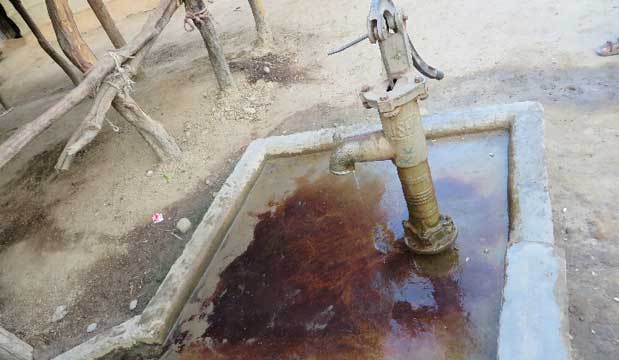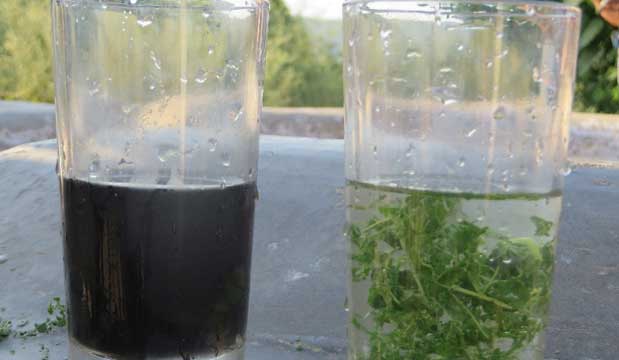By Avash Pandey, ICIMOD
Studies have shown that the groundwater in many areas in West Bengal and Bangladesh are contaminated and the number of villages affected has risen drastically in the past decade. The problem might not only be confined to these regions, and it is possible the groundwater in many other areas in the Gangetic Plain, including Bihar, may be contaminated, especially by arsenic (Chakraborti et. al, 2003). Furthermore, the lack of assessments and research on the problem in Bihar has made the area more vulnerable to contamination. Bihar already faces many challenges, including floods, and this added challenge can be difficult for the people to cope with. HI-AWARE organised a field trip to Bihar to hold discussions with policymakers and interact with villagers in order to address and present adaptive measures for the communities. We visited several villages that are prone to floods and are also facing groundwater-contamination problems.
In the villages in Bihar, it is not uncommon to see skin rashes on the children, women and elderly. When first meeting them, researchers like us might conclude that the rashes are the result of a lack of sanitation and hygiene. But when you get talking to them and probe further, then you will be shocked to realise that the rashes are probably caused by arsenic poisoning.
How on earth are the villagers being poisoned by arsenic? You have to literally dig deep to find the answers under the surface of the earth in the groundwater. But how can the people be so neglectful as to poison themselves? Well, they just don’t know about it.
Recently some NGOs, or a cluster of them, such as MPA (Megh Pyne Abhiyan) and Water Action, a West Champaran based local partner organisation, has has been working on awareness campaigns regarding groundwater contamination as part of the ongoing Participatory Groundwater Management (PGWM) program. The downstream areas of the Gandak and Koshi rivers are inhabited by vulnerable communities who face various problems to do with drinking water. Although they live on basins whose rivers are filled by crystal clear water from the melting glaciers upstream, by midstream, the river is heavily polluted. As a result, there are chances that the groundwater getting contaminated as well. In the past, they were drinking water from the river and dug-wells but now they rely on tube-wells, which are convenient because they can be installed right in front of their porches. Dug-wells are more suited for a whole community and they are usually dug somewhere near the centre of the village. Due to convenience afforded by tube-wells, villagers today prefer tube-wells to dug-wells, but by opting for tube-wells, they are increasing their risk of drinking contaminated water. Bihar has in the recent past has seen uncontrolled and unregulated installations of tube-wells.
 Photo 1: Iron stains left behind from tube-well water.
Photo 1: Iron stains left behind from tube-well water.
But why are tube-wells so susceptible to contamination and why aren’t dug-wells? Since dug-wells are open, the oxygen reacts with the water and oxidises the iron in the water, leaving the well free of iron. The locals also have a traditional practice of splashing their buckets a few times in the wells, but few know how this practice helps enhance oxidation of the water. Another advantage of the dug-well is that the water gets filtered as it drips into the well from the walls made of bricks and sand. This makes the well a well-filtered water-storage system. The tube-well, on the other hand, is a closed setup, and owing to its closed design, its water does not get the oxygen needed to facilitate oxidation. This knowledge about how water gets oxidised could be life-saving for the communities that consume groundwater. NGOs such as MPA and Water Action have worked in villages to revive dug-wells, many of which had been converted into trash bins by the locals. The villagers have been encouraged to clean the wells both inside and out so that they can easily avail of iron-free drinking water. The villagers have also been encouraged to build a higher wall around the dug-well and a higher platform around them, which gets constructed based on the highest flood water levels in past 10 years in the region– an adaptation measure to protect the wells from the floods that are frequent in the region.
That the iron level in the groundwater is high can be easily seen from the iron stains on the tube-well platforms – the stains turn into large swathes of a ferrous colour after some years of a tube-well’s installation (Photo 1). It is not that the stains are going unnoticed, but there is a clear lack of responsibility and education about the contamination. On the other hand, the dug-well platforms do not show this kind of stain, which proves that the level of iron in their water is much lower.
 Photo 2: The guava-leaf test to detect iron-contamination of water.
Photo 2: The guava-leaf test to detect iron-contamination of water.
The locals have come up with their own adaptation measures to check the contamination in the groundwater: the guava- leaf test. The test also illustrates how rich our traditional knowledge is. This test is done to check the presence of iron in the water.
This is how it is done: Two glasses are filled with water, one with water from a dug-well and one with water from a tube-well. Crushed guava leaves are then dropped into the glasses. The glass containing dug-well water turns greenish and the glass with tube-well water turns blackish (Photo 2). This test is consistent because laboratory tests provide the same result. This test can play an important role in awareness-raising campaigns.
Sanitation and hygiene is another issue that the communities are facing challenges with. During the monsoon, the villages get water-logged; moreover, the people defecate in the water and drink the same water. These lead to various waterborne diseases. Water filters have been provided to the villagers by MPA – the organisation provides the idea and the technology. Their water filters are very cheap to make and use local resources such as mud pots, sand, coal and rocks. This adaptation measure helps reduce the community’s vulnerability to water contamination.
Another adaptation measure that came to our notice had to do with how the locals managed the waste-water created by tube-wells. They had planted banana trees in the spots where the water would collect, to prevent water-logging. Such pools with logged water present a health risk because they are a breeding ground for parasites and mosquitoes. This idea was provided by representatives of EcoVida Sao Miguel, a Brazil based organization to MPA and Water Action, and the locals seem to have taken the recommendations seriously. MPA’s work in the villages can also be viewed as examples of how effective communication strategies can be designed: the government has come up with similar ideas but it has been unable to communicate its ideas to the locals.
Despite some of the interventions mentioned above, as a whole, though, the vulnerability of the locals has been increasing, owing to the water-contamination problem: this is mostly so because there is a lack of guidelines for water sampling density, to determine the water quality profile of the state. The ‘safe’ and ‘unsafe’ marks on the tube-wells have either washed away or are not been renewed after the initial testing. There is also a lack of coordination among research groups working here, for which the community is paying the price.
However, research done by MPA in in 22 panchayats (village councils) across five districts (Supaul, Saharsa, Khagaria, Madhubani and West Champaran) of Bihar, which incorporates the findings of various research groups has led to the conclusion that 73 percent of tube-well samples had more iron than the desired amount and 20 percent of dug-wells samples had more iron than the desired amount. Similarly, 24 percent of the tube-well samples had arsenic beyond the desired amount and 15 percent of dug-well samples had arsenic beyond the desired amount. The main challenge now is to pass on this information to the locals so that they know about the contamination of their drinking water. The populations in such rural areas of Bihar normally do not see the effects of policies that are made by the state government, and if immediate mitigation measures are not provided, these communities will continue to fall prey to severe water-contamination.
